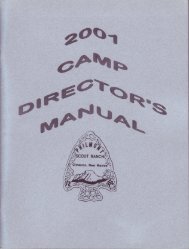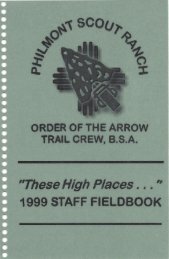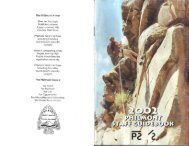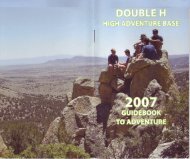Guidebook 2008.pdf
Guidebook 2008.pdf
Guidebook 2008.pdf
You also want an ePaper? Increase the reach of your titles
YUMPU automatically turns print PDFs into web optimized ePapers that Google loves.
SHARPEN YOUR HIKING AND CAMPING SKILLS<br />
Time and effort spent in sharpening your hiking and camping skills will<br />
allow you more time to enjoy the natural beauties and program features of<br />
Philmont. The best way to practice and develop these skills is to participate in<br />
several outings with your crew. Use the Backpacking Merit Badge pamphlet<br />
or Venture Backpacking pamphlet to guide your preparation and training.<br />
Gathering Your Equipment<br />
Backpacking requires proper equipment just as any outdoor sport. Without<br />
suitable equipment you will face unnecessary hardships. Take only what you<br />
need. After several overnight camps you should be able to conduct your own<br />
shakedown to eliminate items that you didn't need. Remember, the key to<br />
successful backpacking is to go lightly. Check your equipment against the<br />
recommended list on pages 12, 13 and 14. This is the maximum. All backpackers<br />
can reduce this list and still be comfortable, clean and safe.<br />
Organizing Your Crew<br />
A well-organized crew gets its chores accomplished quickly and has more<br />
time to enjoy Philmont. Your crew should be organized before you arrive at<br />
Philmont. If your crew is a chartered unit, this should be easy. If your crew is<br />
a provisional council group, it is especially important to be organized.<br />
Each crew should elect a Crew Leader several months prior to coming to<br />
Philmont. Your Crew Leader is responsible for organizing the crew, assigning<br />
duties, making decisions and recognizing the capabilities and limitations<br />
of each member. He or she leads by example and discusses ideas and alternatives<br />
with the entire crew to arrive at a consensus before taking action. This<br />
responsibility requires someone with leadership ability who is respected by<br />
everyone.<br />
Each crew should also select a chaplain aide, perhaps a member of the crew<br />
who has received a religious award in Scouting. The chaplain aide is responsible<br />
for assisting the crew in meeting their responsibility to the 12th point<br />
of the Scout Law, as well as working with the Crew Leader and Advisor to<br />
ensure the smooth operation of the crew.<br />
The Ranger assigned to serve as a resource for your crew may be either male<br />
or female. This person serves as a teacher and a resource for your crew and<br />
helps to coach the Crew Leader as well as the entire crew. You and your<br />
crew are expected to treat your Ranger with respect, regardless of gender.<br />
Your adult Advisor counsels and advises your Crew Leader and crew. The<br />
Advisor assists if discipline is required. With the assistance of your Ranger,<br />
your Advisor is responsible for ensuring the safety and well-being of each<br />
crew member. The Advisor lets the Crew Leader lead the crew.<br />
The entire crew and especially the Crew Leader and Advisor need to effectively<br />
relate to everyone in the crew. Crew congeniality is important to crew<br />
harmony. Make it a point to say something positive to each member of your<br />
crew at least once a day. Tell each person what he or she did well.<br />
Good communication is crucial to your crew's success. Make sure that<br />
everyone participates in determining the objectives for the crew each day.<br />
After the evening meal is an ideal time to accomplish this.<br />
Remember, when you are hot and tired, hungry and irritable, so is your<br />
crew. Everyone is expected to control personal behavior, especially when<br />
the going is tough. The Crew Leader needs to continually monitor the<br />
crew's dynamics.<br />
A daily duty roster will help to organize your crew. Each crew member is<br />
assigned a responsibility for each day. Jobs should be rotated so that at least<br />
one experienced and one new crew member work together. Every job should<br />
be clearly defined. Your crew should have a list of all tasks for each job so<br />
that everyone knows what is expected. A form is provided with your Crew<br />
Leader's itinerary outline upon arrival at Philmont.<br />
Backpacking - Setting the Pace<br />
If you pack properly, backpacking will be much easier. Practice hikes will<br />
help. Your pace is the key to good backpacking. It should be slow enough<br />
to allow everyone to keep together without bunching up. Single file is the<br />
rule. A steady, constant pace is best. When climbing steep grades, your pace<br />
should be slower, but still constant. Always keep your crew together. A medical<br />
emergency is the only reason to separate from your crew.<br />
Rest stops should be short and frequent. Any member of the crew can call<br />
for a rest stop at anytime. Sixty second rests will let you catch your breath.<br />
Learn to rest without removing your pack; if you bend over and loosen your<br />
hip strap, you can remove the weight from your shoulders. Deep breathing<br />
works best for high altitude backpacking on Philmont.<br />
Conserving Energy<br />
Use as many energy-saving techniques as possible; nibble snacks and drink<br />
plenty of liquids to sustain you throughout the day. On steep ascents, use<br />
the "rest step". Place the sole and heel of one foot flat on the ground. Lean<br />
forward and momentarily lock your knee. For an instant the bones of your<br />
leg and hips will support your weight, allowing the muscles of your thigh and<br />
calf to rest. Repeat this sequence with your other foot. Your pace will be slow,<br />
but you will save energy and make steady progress up the mountainside.<br />
Use "rhythmic breathing" in conjunction with the rest step. To breath rhythmically,<br />
synchronize your breaths with your steps. On moderate slopes, take<br />
one breath per step; on steep slopes, take two or three breaths per step to take<br />
in more oxygen.<br />
8<br />
9

















